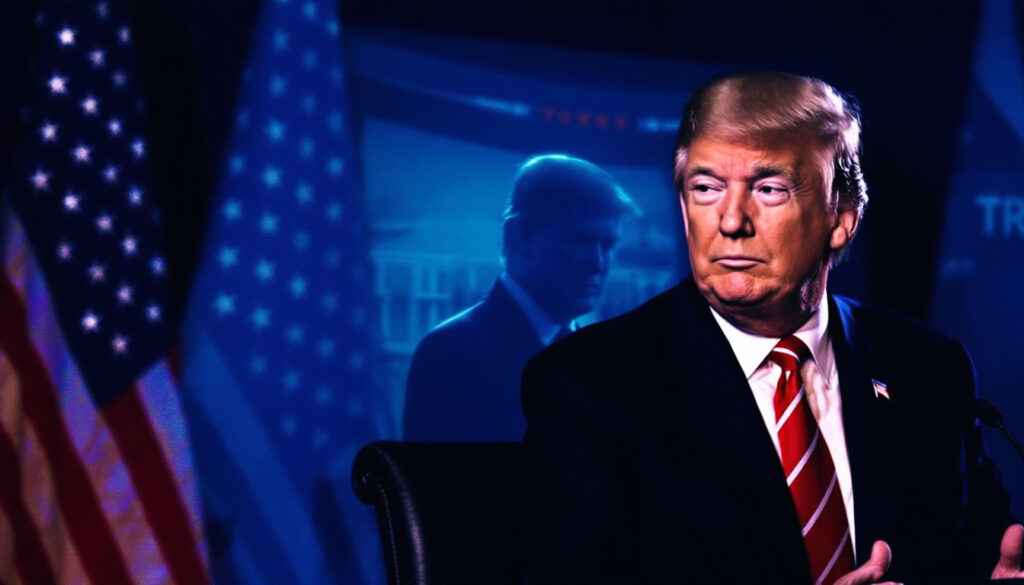The Structure and Objectives of President Trump's Tariff Policy
Key Components of the 2025 Tariff Framework
The tariff regime, enacted via executive order on April 2, 2025, introduced a bifurcated implementation timeline. A blanket 10% duty on all imports took effect on April 5, followed by country-specific rates ranging from 11% to 50% targeting 57 nations on April 9. This structure aims to incentivize domestic manufacturing realignment while addressing perceived trade imbalances. The policy builds on Trump's market influence but scales interventionism to unprecedented levels—total import coverage exceeds previous administrations' measures by 300%, encompassing $5.8 trillion in annual traded goods.
Historical Context and Strategic Aims
Unlike the targeted sectoral tariffs of Trump's first term, the 2025 policy adopts a systemic approach to recalibrate global supply chains. PWBM analysts note the tariffs explicitly seek to reduce the U.S. trade deficit, which stood at $1.1 trillion in 2024. However, the model identifies contradictions in this objective: while tariffs depress import volumes by $6.9 trillion over ten years, parallel reductions in foreign capital inflows ($37 trillion through 2054) create countervailing pressures on domestic interest rates and investment. The policy's architects argue it will accelerate reshoring, but evidence from prior protectionist measures shows mixed results—the 2018-2020 steel tariffs boosted domestic production by 12% but cost downstream industries $68 billion in higher input costs.
Fiscal Implications: Revenue Generation and Debt Dynamics
Projected Revenue Streams
PWBM's conventional static scoring estimates $5.2 trillion in tariff revenue through 2034, falling to $4.2 trillion under partially dynamic assumptions that account for reduced import demand. Over a 30-year horizon, cumulative collections reach $16.4 trillion, providing short-term debt relief. By 2030, federal debt is projected to decline by 5.4% under full consumer incidence scenarios. However, these gains diminish post-2040 as economic contraction erodes the tax base—by 2054, debt reduction narrows to 4.1-6.0% depending on burden-sharing assumptions.
Import Compression and Capital Market Effects
The Trump tariff fears will reduce import values by $319 billion in the first year, escalating to $1.1 trillion annually by 2034. This import suppression alters international balance sheets: foreign purchases of U.S. Treasuries are projected to fall by $2.1 trillion annually, forcing domestic savers to absorb 78% of federal debt issuance by 2035 compared to 42% in 2024. The resulting capital scarcity elevates marginal product of capital (MPK) by 1.8 percentage points, crowding out private investment in favor of public debt instruments.
Macroeconomic Consequences: Growth, Wages, and Consumption
Three-Channel Transmission Mechanism
PWBM identifies three primary transmission channels:
- Direct Tax Incidence: Consumers and businesses share tariff costs through price increases, with elasticity analysis suggesting 60-75% pass-through to end-users depending on sectoral competition levels.
- Capital Flow Reduction: The $37 trillion import contraction through 2054 depresses foreign savings inflows, necessitating a 14.9-17.4% reduction in domestic capital stock.
- Policy Uncertainty: The Economic Policy Uncertainty (EPU) Index doubled from January to March 2025, reaching levels last seen during COVID-19 lockdowns. Applying Baker-Bloom-Davis methodologies, this uncertainty suppresses 2025 investment by 4.4%.
Sectoral and Aggregate Impacts
By 2030, the economic effects of President Trump's tariffs reduce GDP by 1.1-1.2% annually, accelerating to 7.7-8.9% by 2054. Wage compression mirrors this trend, with real earnings falling 6.5-8.4% over three decades. Consumption declines prove regressive: under full consumer incidence, middle-income households suffer 4.5% immediate consumption losses versus 3.7% when businesses absorb half the burden. These differentials reflect varied passthrough rates across product categories—essential goods with inelastic demand exhibit 92% consumer incidence versus 58% for discretionary items.
Distributional Analysis: Winners, Losers, and Intergenerational Equity
Burden Allocation Scenarios
PWBM's tax incidence modeling examines three scenarios:
- Scenario A (100% Consumer): Maximizes short-term consumption pain (4.5% decline) but minimizes long-term capital erosion (14.9% stock reduction).
- Scenario C (50/50 Split): Lowers immediate consumption loss to 3.7% but exacerbates capital depletion (17.4% by 2054), disproportionately harming younger workers through wage effects.
Lifetime Household Impacts
Dynamic distributional analysis reveals universal welfare losses but divergent generational exposures:
- An 80-year-old top-quintile earner loses $205,000 under Scenario A versus $156,800 in Scenario C.
- Unborn households in the bottom quintile face $40,400-$49,700 losses, reflecting diminished future wage growth.
- Middle-income 40-year-olds experience $58,000 lifetime losses regardless of incidence scenario.
These disparities stem from overlapping factors: older households prioritize current consumption stability, while younger cohorts bear capital-driven productivity declines. The analysis highlights trade-offs between immediate price shocks and long-term growth suppression.
Comparative Policy Analysis: Tariffs vs. Conventional Taxation
Corporate Tax Equivalency
Generating equivalent revenue would require raising the corporate tax rate from 21% to 36%—a policy PWBM estimates would reduce 2054 GDP by 3.0% versus 7.7-8.9% under tariffs. The differential stems from tariffs' dual distortion of both product and capital markets. While corporate taxes primarily depress investment (6.9% capital stock reduction), tariffs compound this with consumption losses and import suppression.
Efficiency Metrics and Labor Market Effects
Tariffs introduce deadweight losses 2.3x greater than equivalent corporate tax increases. They also invert labor supply responses: corporate tax hikes increase hours worked by 0.5% through income effects, whereas tariffs reduce labor participation by 1.3% via real wage erosion. These findings challenge political narratives framing tariffs as "pro-worker" interventions.
Model Limitations and Unquantified Risks
Underestimated Contagion Effects
PWBM acknowledges conservative assumptions about manufacturing reshoring, presuming no total factor productivity (TFP) losses during supply chain reorganization. Real-world disruptions could exacerbate declines—the 2018-2020 trade war reduced automotive sector TFP by 4.1% due to supplier fragmentation. Additionally, the model assumes constant government borrowing rates despite debt-to-GDP ratios exceeding 200% by 2040, potentially underestimating interest cost spirals.
Cross-Border Interdependencies
Modern manufacturing's integrated networks—where intermediate goods cross borders 3.2 times on average before final assembly—create vulnerabilities absent from conventional trade models. Tariff-induced reshoring could fracture these networks, imposing efficiency losses beyond PWBM's estimates. Understanding the market dynamics insights reveals that semiconductor industry analyses suggest 10-15% cost inflation from localized production, compounding consumer price pressures.
Expert Assessments and Policy Recommendations
PWBM's Concluding Analysis
"Tariff policies reduce economic output and worker remuneration more severely than even highly distortionary corporate tax increases," summarizes PWBM Director Kent Smetters. The model urges policymakers to consider targeted subsidies over blanket tariffs, noting that R&D incentives generate 3.2x greater domestic job growth per fiscal dollar spent.
Mitigation Strategies
For existing tariffs, PWBM recommends:
- Phased Implementation: Gradual rate increases to allow supply chain adjustment, minimizing productivity shocks.
- Small Business Exemptions: Threshold exemptions for imports under $500,000 to protect downstream industries.
- Rebate Programs: Direct consumer rebates on essential goods to alleviate regressive impacts.
These measures could reduce GDP losses by 1.7 percentage points while preserving 43% of intended protectionist benefits.
Synthesis and Path Forward
The 2025 tariff regime underscores the tension between populist trade rhetoric and economic reality. While generating substantial short-term revenue, the policy imposes durable costs through capital erosion and productivity declines. Distributional analysis reveals intergenerational inequities that standard fiscal tools avoid. As commodity super cycle patterns evolve, investors should develop geopolitical investment strategies to navigate these changes. According to Tax Foundation research, future analysis should prioritize dynamic modeling of regional trade blocs and sector-specific TFP impacts to refine tariff designs. Above all, this analysis reaffirms that in globalized economies, the economic effects of President Trump's tariffs function as costly taxes on domestic consumers and businesses alike.
Ready to Invest With a Competitive Edge?
Get real-time alerts on significant ASX mineral discoveries with Discovery Alert's proprietary Discovery IQ model, transforming complex market data into actionable investment insights during economic uncertainty. Visit our discoveries page to see how major mineral finds have historically delivered exceptional returns.




